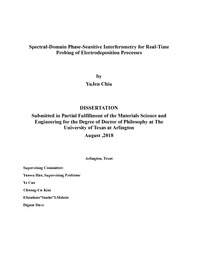| dc.description.abstract | Electrodeposition is a simple, versatile and scalable method for depositing thin metal films on conductive substrates, and it has long been used in large-scale industrial processes for metal film coating. In the last two decades, electrodeposition has entered into the manufacturing processes of electronic devices. Electrodeposition of Cu has become the standard process for the backend processes for almost all microelectronic devices. Electrodeposition of Cu and magnetic materials are used in the fabrication of write/read head in computer hard disk drive. More recently, a unique electrodeposition process, under potential deposition (UPD), has been utilized for atomic layer deposition to generate films layer by layer. Aiming to achieve better control of the microstructures of deposited films, investigating the mechanism of nucleation and growth of metallic phases in the electrodeposition process has drawn significant attention. Most of these studies have employed electrochemical transient measurements. However, due to the stochastic nature at the early stages of electrodeposition, the early stages of metal phase formation models for electrodeposition obtained using current transient responses do not accurately reflect atomic behaviors on the surface of the substrate. More powerful nanoscale characterization tools,including In-situ transmission electron microscopy (TEM), scanning tunneling microscopy (STM),and atomic force microscopy (AFM) have been utilized for investigating the electrodeposition process. However, these in-situ methods usually require particular electrodeposition cells, and more problematically, they all inevitably interfere with the electrochemical process.In this project, we have been developing a new optical method, Spectral Domain Phase Sensitive Interferometry (SDPSI), for in situ monitoring electrochemical processes. Unlike other in situ techniques, PSI does not require individual electrochemical cell. Therefore, it has the potential tobe implemented in practical electrochemical processes. More importantly, PSI does not interfere with electrochemical processes since only near-infrared light (wavelength ~800 nm) interact with electrolyte and substrate. This interferometric detection method is based on the phase–sensitive detection of spectral interference fringes. In this technique, by measuring the phase on aninterference signal, sub-nanometer changes in optical path length can be measured.We used SDPSI to study the cyclic voltammetry (CV) of UPD of Cu on Au surface. UPD is theelectrochemical deposition process of a sub-monolayer or monolayer of metal on different substrates using a potential more positive than the equilibrium potential. It occurs when theadsorbate adatoms are more strongly bound to the different substrate than to a substrate of theirkind. We demonstrated that SDPSI could detect the monolayer film formation in real time,allowing us to “see” the atomic processes at the substrate surface during CV measurements. We proved that SDPSI could be used as a real-time monitor with a sub-monolayer resolution forelectrodeposition. Also, we used SDPSI to study the atomic processes in the pre-deposition and initial deposition stage of general electrodeposition processes. We found that SDPSI can detect accumulation on the substrate surface before the deposition takes place, and accurately predict the initial deposition potential. Also, it has been found that such initial deposition potential has a dependence on the substrate thickness for ultra-thin film working electrodes.We clearly demonstrated that SDSPI is a reliable new tool for real-time probing electrodeposition processes. It can be used as a thickness monitor for electrodeposition, a long-awaited scientific breakthrough. | |


